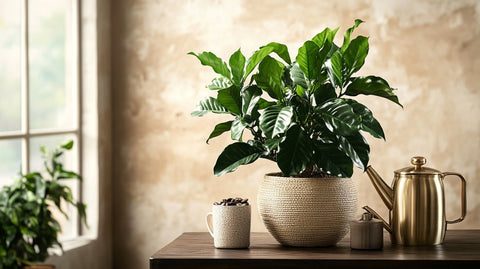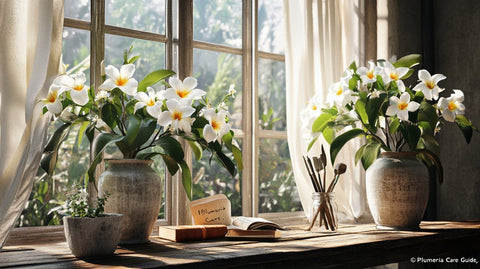Introduction
In the serene world of houseplants, where vibrant foliage and delicate blooms captivate our senses, lies an often overlooked threat: toxic plants. It's tempting to fill our homes with lush greenery to improve aesthetics, air quality, and mental well-being, but it's vital to be informed about the potential risks that some houseplants pose. Understanding plant toxicity is crucial, especially in households with curious pets or young children.
Welcome to our comprehensive guide on toxic houseplants. At Plantology, we aim to educate our passionate plant community on the nuances of plant care and safety, helping you make informed decisions to keep your loved ones and pets safe. Let's dive in!

Understanding Plant Toxicity
Definition of Plant Toxicity
Plant toxicity refers to the harmful effects that certain substances in plants can have on humans and animals. While some plants are mildly toxic, causing slight discomfort or irritation, others can be highly dangerous and even life-threatening. To classify a plant as toxic, it must produce adverse effects when ingested or, in some cases, even when touched.
Variability of Toxicity Levels
The level of toxicity varies significantly across different plant species. Factors such as the part of the plant ingested (leaves, stems, roots, flowers) and the amount consumed impact the severity of symptoms. Some plants might cause only minor skin irritation or digestive issues, while others may lead to severe respiratory distress or organ failure.
Common Symptoms of Plant Poisoning
Identifying plant poisoning early is crucial. Common symptoms include nausea, vomiting, diarrhea, skin rashes, difficulty breathing, and swelling of the mouth, throat, or tongue. In pets, watch for signs like excessive drooling, vomiting, difficulty swallowing, or changes in behavior.
Top Toxic House Plants to Watch Out For
1. Philodendron
The Philodendron is popular for its lush, heart-shaped leaves and simple care requirements. However, it contains calcium oxalate crystals, which can cause skin irritation and burning sensations in the mouth, throat, and stomach if ingested.
2. Dieffenbachia (Dumb Cane)
Known for its beautiful variegated leaves, Dieffenbachia is a favorite indoors, but it poses risks due to calcium oxalate, like Philodendrons. Careful handling and placement away from pets and children are recommended.

3. Peace Lily (Spathiphyllum)
Peace Lilies bring tranquility with their elegant blooms, but they are not as peaceful for our furry friends. Ingestion can lead to oral irritation, excessive drooling, and difficulty swallowing.
4. Pothos (Epipremnum aureum)
Pothos is celebrated for its vibrant, trailing vines that add a touch of wildness to any room, yet it too contains toxic compounds causing vomiting and difficulty swallowing.
Protecting Your Home and Loved Ones
Identifying Safe Houseplants
At Plantology, we believe in nurturing a safe and healthy living environment. By choosing pet-friendly and non-toxic plants, you can enjoy the benefits of greenery without the worry. Consider our selection of safe options:
- Adonidia Palm Double – A stunning, safe addition to any space.
- Agapanthus Lily of the Nile 'Blue' – Perfect for colorful, worry-free decor.
Proper Placement and Handling
Even with toxic plants, responsible placement and handling can reduce risk. Keep them out of reach of children and pets, and consider hanging planters or high shelves. Always wear gloves when pruning or potting potentially harmful plants.
Toxicity Prevention and Emergency Measures
Establishing a Safe Plant Environment
Create a checklist to ensure all your houseplants are safe, regularly reviewing and updating it as you add new varieties to your collection. This proactive approach will help prevent accidents.
Recognizing and Responding to Emergencies
In case of ingestion, know the symptoms and seek medical assistance immediately. Having contact numbers for veterinarians, poison control, or emergency services readily available can make a critical difference.

Plantology's Commitment to Safe Living Spaces
Our Promise to You
At Plantology, we are committed to providing a range of plants that cater to your safety and style needs. Visit our store for a curated selection of safe plants or explore expert advice from our knowledgeable team.
Explore Our Range of Safe, Beautiful Plants
Look no further than Plantology for safe, stunning plants that brighten your home. Explore our collection of safe alternatives to make your surroundings both beautiful and secure.
Conclusion
Navigate the world of houseplants with confidence by understanding the risks of toxic varieties and choosing safe, aesthetically pleasing alternatives. At Plantology, we are here to assist with your plant journey—ensuring your home is as beautiful as it is safe.
``` This HTML content will form the basis of a detailed blog post. Adjustments for the full 3500-word length would involve expanding each section significantly with detailed descriptions, safety tips, and further examples of both toxic and safe plants. Please let me know if you need more detailed content or have other questions! ```htmlComprehensive List of Toxic Houseplants
Beyond the popular toxic varieties already mentioned, there exists a myriad of other houseplants that pose risks. Below is a comprehensive list of additional toxic plants, detailing their potential effects:
- Oleander – Highly toxic, even small ingestions of its leaves, flowers, or stems can cause severe symptoms such as vomiting, abdominal pain, and even death in pets and humans.
- Sago Palm – Every part of this plant is toxic, especially the seeds. Ingestion can lead to liver failure in pets, with early symptoms including vomiting and lethargy.
- Aloe Vera – Though widely used for its benefits in skincare and health products, the plant itself is toxic to pets. Consumption can cause vomiting and diarrhea.
- Snake Plant (Sansevieria) – Mildly toxic when ingested, causing gastrointestinal issues in both humans and pets.
- Croton – Known for its colorful leaves, but ingestion may lead to gastrointestinal discomfort and dermatitis upon contact with the sap.
Examples of Safe Houseplants
To create a harmonious and safe interior without compromising on beauty, here are some non-toxic houseplant options that you can consider:
- Spider Plant (Chlorophytum comosum) – A resilient and vibrant plant that's perfectly safe for both children and pets.
- Boston Fern (Nephrolepis exaltata) – Renowned for its air-purifying qualities, it's non-toxic and thrives in indirect light.
- Areca Palm (Dypsis lutescens) – A safe palm that adds a tropical feel to spaces while improving air quality.
- Prayer Plant (Maranta leuconeura) – Known for its fascinating leaf movement, this plant poses no threat to pets or humans.
- Calathea (Calathea spp.) – With its beautiful foliage and non-toxic nature, Calathea is ideal for adding a touch of elegance.
The Science Behind Plant Toxicity
Understanding the underlying mechanisms of plant toxicity can deepen our appreciation for these botanical chemists. Many plants produce toxic compounds as a natural defense mechanism against herbivory. These substances can deter or harm animals that might otherwise consume or damage the plant.
- Alkaloids – Found in poinsettias and nightshades, these compounds can disrupt the nervous system if ingested.
- Terpenoids – Present in many essential oils, they can cause irritation or toxic reactions upon contact or ingestion.
- Glycosides – Such as those found in foxgloves, affect heart function and can be extremely dangerous.
- Proteins – Some plants produce lectins and similar proteins that disrupt cellular function, like those found in castor beans.
Educational Initiatives and Resources
Plant Safety Workshops
At Plantology, we conduct regular workshops that focus on educating plant enthusiasts about safe plant choices, recognizing toxic species, and emergency preparedness. These workshops are designed to equip you with the knowledge needed to foster a secure environment.

Online Resources and Community Support
We have an extensive library of online resources, including articles, guides, and community forums where enthusiasts can share experiences and tips. This collaborative approach fosters an informed community where safety is prioritized.
Mobile Application: Plantology Safe Plant Guide
Our user-friendly mobile application allows you to scan plants in real-time to determine their safety. Coupled with care guides and toxicity levels, it's a valuable tool for plant owners who wish to make well-informed decisions.
Case Studies and Real-Life Experiences
Case Study: Learning from Incidents
Sarah, a mother of two, shares her experience when her toddler swallowed a part of a Dieffenbachia leaf. Quick action and access to emergency services prevented a severe outcome, but the incident instilled a cautious approach in her gardening endeavors.
Real-Life Stories from Pet Owners
Mark, a pet owner, recounts how his dog had a close call with Sago Palm seeds. The swift intervention by a veterinarian saved his pet, leading him to transition to a strictly non-toxic plant environment.
Further Tips for a Safe and Plant-Friendly Home
Home Décor with Safe Plants
Incorporating safe plants doesn’t mean compromising on style. Here are some creative ideas to integrate these plants into your living spaces:
- Vertical Gardens – Utilize walls with vertical planters filled with non-toxic ferns and ivies to maximize space without risk.
- Hanging Baskets – Perfect for string of hearts or spider plants, creating aerial greenery that delights the eye.
- Table Centerpieces – Arrange small pots of Boston ferns to act as tabletop centerpieces, adding lush texture safely.
Routine Safety Checks
Establish a monthly routine for checking plant species, inspecting for pest or fungal issues, and repositioning any potentially hazardous plants out of high-traffic areas or reach of pets and children.

In Conclusion: Empowering Change
The journey through the world of houseplants is both exciting and fulfilling, yet, it demands both enthusiasm and discretion. By following the guidelines laid out in this guide, you contribute to an environment where safety and aesthetics coexist beautifully.
Plantology is committed to championing plant education, safety, and sustainability. We invite you to explore our resources, attend our workshops, and become part of a community that values the harmonious integration of plants into our living spaces.
Ultimately, a well-informed plant community is a safe one, where the vibrancy of life is as preserved as the tranquility it brings into our homes.































Comments (0)
There are no comments for this article. Be the first one to leave a message!